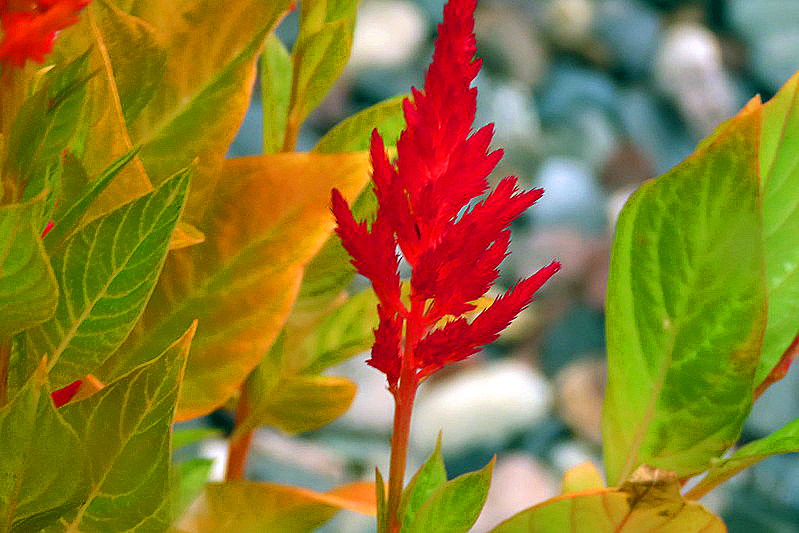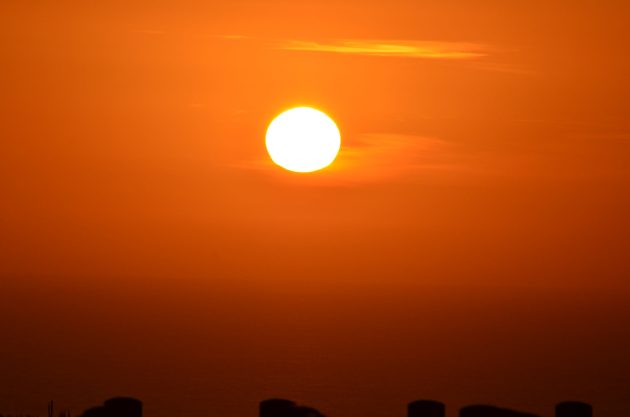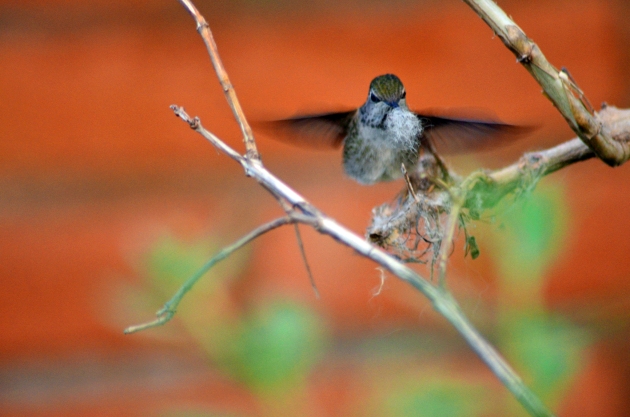We are Norwegian, German, stubborn and fighters. This is our place, and we’ll stay here.
Steve Carbno, disaster coordinator for the Salvation Army, Fargo, ND
Hurricane Harvey, that still ravages Texas, brought back many memories from our experiences with a record flood in 2009. I am sorry for the people affected by this hurricane: their lives with be changed forever and the road ahead will be difficult and exhausting.
Our story:
The fall of 2008 brought record rainfall to Fargo, ND/Moorhead, MN–across the Red River from one another. December had more snow than any month in history. Worried about spring floods, I added more flood insurance. Throughout the winter, I watched the weather daily: Would it snow, might it melt some, what were the flood predictions? I went on a 3-week photo trip out West at the end of January, 2009. I checked the weather back home every day.
As March began, the National Weather Service predicted a flood crest in the mid to high 30-foot range. Dennis Walacker — who was the mayor of Fargo, North Dakota, and had been public works director in 1997, and who was credited with saving Fargo from the flood that year — thought the crest would be lower. Our home would be safe to almost 39 feet.
The flood came early, fast, and big.
We began to sandbag on March 20, 2009. Melanie was born and raised in this region, and her mother and eight of her brothers and sisters lived in the area. They had children and some of their children had children. They turned out in force to help. Many came back day after day. Melanie’s mom, sisters, friends, and co-workers took over the kitchen. Workers were well fed.
Melanie was a good friend to many, and those friends turned out en masse. Her professional colleagues were tremendous in their help and concern. We had members of the girls’ volleyball team from North Dakota State University and a high school wrestling team help out. Helpers included bankers, coaches, teachers, builders, farmers, attorneys, scientists, garbage men, federal agents, retired folks, and the students. Without the students — from grade school through college — Fargo/Moorhead would have been lost to the flood.
Three days later, we had filled approximately 20,000 bags with 35 pounds of sand each. As many as 150 people worked at once. It was an amazing example of self-organization — the chaos of people coming together for a common purpose came to order and did so quickly. People did what they could, leaders emerged and leadership shifted naturally, creativity took over, and rules took a back seat. Skid steers tore around our yard carrying filled sand bags. It broke Melanie’s heart to see her yard and landscaping torn up, but survival becomes the sole priority in a crisis. We worked in rain, snow, and mud. People cared, and fought to protect their property and that of their friends and neighbors. Laughter filled the air, and we felt a powerful sense of purpose and community. I’ve never been part of such an expenditure of energy before; people working together was a magnificent sight to see.
Each day the predicted crest got larger. Over a few weeks, it went from 34 feet to 42-43 feet. During the days we sandbagged, the crest prediction rose a foot or more each day. Every time we thought we were finished, we had to dig a little deeper within ourselves and pile the bags higher. We were exhausted, but our core group of men and women would not stop. We thought we were done when our dike protected our home to 40 feet. Overnight it snowed 7 inches. The flood and snow scenes were surreal. Climbing over the plastic-covered dike was a slippery venture.
Later that day, the National Weather Service — a constant source of frustration — raised the crest prediction by another foot. We went to work yet again. The heartiest among us pulled a boat through the strong current and freezing slush to the dike on the road that led to our home. They then walked through snowdrifts to their pick-up trucks a couple of blocks away. They went in search of filled sandbags, loaded their trucks, and returned. They loaded the sandbags onto sleds, pulled them through the snow and over the dike, and loaded them into the boat, which they pulled through the slush and fleeing voles to the house where they stacked them onto the dike. This work went on from late afternoon until 1:30 a.m. We again thought we were OK.

Our home surrounded by water.
The next afternoon, they raised the crest prediction again — this time, to 42-43 feet. We were surrounded by water. We went to work again in the late afternoon and followed the same process as the day before. We worked deep into the evening. Suddenly we had sewer backup in our basement. The public works department had shut down the lift station without telling us. Melanie slammed the state-of-the art sewer shut-off down and the backup stopped, but the damage was done. From now on, the toilet would be a bucket outside.
Then the authorities ordered an evacuation of all residents in a huge part of the city. A 43-foot flood would devastate the community. We didn’t know then that they had no authority to “order” an evacuation. They meant well, but they scared us, and we decided to evacuate.
At about 9:00 p.m., it was time to go. Melanie locked the door and climbed over the sandbags. She was the last person out of the house and into the boat. As we left our neighborhood, a plow closed the road behind us.
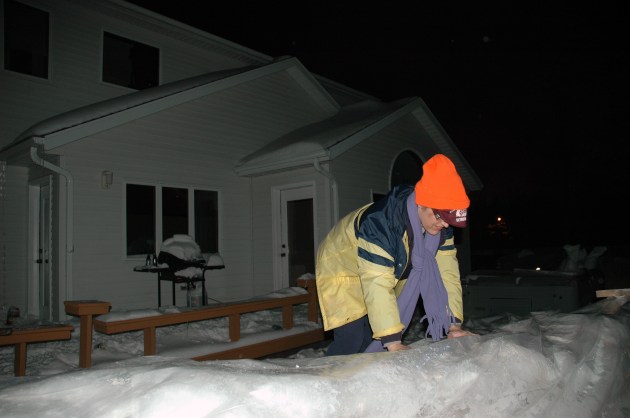
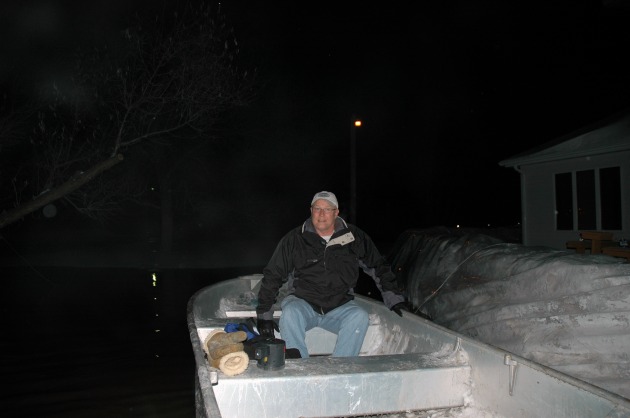
The next morning, two family members boated to the house. Our dike had held. No water had gotten under the dike, over it, around it, or through it. When they took the dike down many weeks later, the Army Corps of Engineers supervisor said it was one of the best-built dikes he had ever seen.
But a back-up sump pump had failed, and we had 9 to 12 inches of water in our finished basement, along with the sewer backup. We had moved many things of value to the second floor, but there was still a massive amount of accumulated stuff floating around the basement.
The harm was done. A costly finished basement was ruined, and many possessions were contaminated. Our furnace, water heater, and freezer were destroyed. The house smelled of sewage. Carpets on the main floor and top floor were caked with mud from the frantic efforts of a dozen or more volunteers to move our possessions to the top floor. Our yard and landscaping were ruined by the dike-building process. Our road was torn up by sand trucks. Two neighbors lost their homes. Others had water damage worse than us.
Family members spent several nights in the house and watched the dike and pumps. Melanie and I stayed with Melanie’s mother for a week. Our dogs were farmed out to relatives. We adapted by the minute.
A few days after evacuating, we returned home. We parked a few blocks away. We used the sled and walked through snow, water, and mud in waders and got to the dike. We climbed over it and got some necessities and put them into garbage bags. We carried them over the slippery dike and onto the sled and pulled it to our car. After two trips, we were exhausted.
Four days after we left, we got another 10 inches of snow — 17 inches in less than a week — along with heavy rains while we sandbagged, a record flood, and blizzard winds. There was a second, maybe even higher, crest on the way. The city looked like an exhausted war zone.
Finally, they rescinded the mandatory evacuation and opened the dike on the road so we could drive to our home. The water had receded across the road. The city inspectors and insurance adjusters began to show up. The birds and wild turkeys returned.
The city declared our home uninhabitable.
Two homes in our neighborhood of 11 houses were destroyed. Three others had water in the basement. The peninsula was a mess from the clay dikes, home dikes, and roads damaged by heavy equipment. The second crest was lower than predicted. The clean-up began.
Fighting the record flood was the easy part.
Our home had 20% damage, according to FEMA. Fighting the flood was an exhilarating, high-energy experience — the best experience of creative chaos I’ve had. Cleaning the mess up afterwards and going to our wounded home and neighborhood were sad, painful, and depressing encounters with death and destruction. We rented a townhome in Fargo while we cleaned up. We would never again live in our home.
The neighborhood looked like a war zone after the flood waters receded: fences down, roads torn up, landscaping destroyed, sandbags stuck in the trees and buried in the ground, homes surrounded by sandbags and then dirt rings after the Army Corps of Engineers took the dikes down. Mud was tracked everywhere for weeks afterward. We cleaned water and sewage from our basement, ripped out wallboard, and threw away truck-loads of possessions accumulated over 15 years.
We entered a neutral zone of uncertainty and not knowing about our lives. About half of our neighbors wanted to stay, and began to explore ways to make their homes safer by elevating them, or building a clay dike or a concrete wall. The rest wanted to leave. For us, four floods in 12 years were enough. For others, this record flood was the first time they were threatened and once was enough. As one neighbor said about our once safe neighborhood, “Maybe nature doesn’t want us here anymore.” Melanie and I vowed to turn this disaster into an opportunity for transformation.
I knew that a neutral zone (the place between endings and beginnings) wasn’t just a place of confusion and uncertainty. The neutral zone can also be a condition for creativity if we can live with the discomfort and anxiety for a time.
Often people go into submission after a disaster and let others decide their destiny. We would not go quietly into compliance and submission to the bureaucracies and to those who re-victimize victims. We would assert ourselves, ask questions, and push back on bureaucratic pronouncements. We would attend every meeting held, and we would tell our story and express our opinions to anyone who would listen. We wanted to influence the chaos around us and shape our own future.
Part of me enjoyed the challenges of the flood’s aftermath. Another part of me felt scared of entering into new and bureaucratic domains. We fought for what we believed was right with insurance companies. I sent letters to the politicians and did what I could. I attended every City Council meeting for months after the flood and asked questions and told our story to the mayor, city manager, council members, and city engineer every chance we got. We found them to be good and caring people, willing to listen.
We expressed our fears of future floods with our elected state and federal officials. I visited the disaster center three times to try to get answer to my questions from FEMA and SBA officials. The front-line people were awesome: caring and compassionate. The bureaucracy — excessive process and slow to act — exhausted us, numbed our minds, and extended our patience to the breaking point. The rules, language, processes, procedures, and regulations were complicated and hard to understand. It would take about 1½ years to work through all the issues and bring the flood follow-up to a conclusion.
Our home was put in a project for buyouts. I asked the city engineer what motivated putting our home in this proposed FEMA project. He replied, “Because it makes sense.” That’s what responses to disasters need more of: what makes sense.
From time in the neutral zone, new visions form if we will live with uncertainty for a time.
Just before the flood, a job opened up in Minneapolis (225 miles southeast of us) that Melanie was interested in. The flood was traumatic for both of us but more so for Melanie, who had built the home and raised her three children there. She lost many possessions in the flood that held meaning for her. For her the beautiful home died the day the water came in. She did not want to return. She decided to go forward with her job application. Like everything at this time of our lives, the job process moved slowly.
We imagined and thought through different scenarios for what might happen with the job and our home. In our hearts, we most wanted to go to Minneapolis. My two daughters and five grandchildren lived there. I also looked forward to renewing old friendships from decades of earlier life in the Twin Cities. Two of Melanie’s three children would be living in Minneapolis that fall. The job would be a professional advancement and a challenge Melanie would enjoy. She would get to use talents and skills honed over a 30-year career.
We envisioned new adventures in our upcoming lives as empty-nesters and grew more and more excited. We decided that if Melanie got the job, we would go regardless of the fate of our home.
Suddenly things began to happen: Melanie was offered the job and compensation was negotiated and agreed upon quickly. Within 72 hours we had rented a beautiful home 15 minutes from her new workplace. Melanie gave her notice in Fargo and began work in Minneapolis 10 days later. We moved our possessions a month after that. The city purchased our home for a fair price a few months later. A year later, we purchased a new home. Melanie thrived in her new job.
The natural disaster created the conditions for us to renew our lives. We refused to be victims. Despite the difficulties, we felt alive as we grieved our losses. We grew as people. And, in the midst of a contentious time in America, we experienced the deep goodness and decency of the people around us. We will be forever grateful to them for the help they gave us.
Best wishes Texas.
